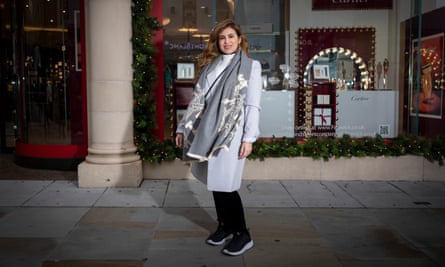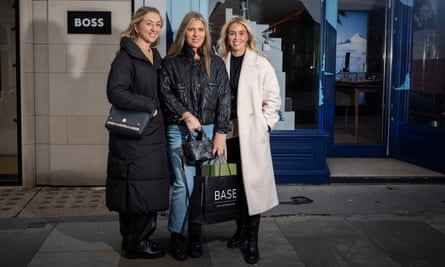Arwa Alhudhayei and Najla Ahmed are on a spending spree. Walking down New Bond Street – the London home of many of the world’s most expensive luxury brands, including Louis Vuitton, Chanel and Hermès – Arwa lets slip that she spent more than £2,000 the day before.
Najla won’t tell the Guardian how much she spent because, she claims, she doesn’t know. “Oh my God,” she says. “It’s such a difficult question, I don’t want to remember how much I spent. It’s hard.”
Arwa, who is wearing a grey and white Hermès scarf (£500) she bought yesterday, says the pair, who are visiting from Saudi Arabia, will probably spend about the same today.
 View image in fullscreenArwa Alhudhayei from Saudi Arabia. Photograph: Alicia Canter/The Guardian
View image in fullscreenArwa Alhudhayei from Saudi Arabia. Photograph: Alicia Canter/The Guardian
They have spent a lot of money at Harrods because “we like anything with the Harrods name on it, like specialty tea, chocolate and biscuits”.
They also popped into Balenciaga for a £550 T-shirt. A bargain, perhaps, as it turned out to be one of the cheapest items in the store when the Guardian visited to see the brand’s new collaboration with Adidas.
Baggy tracksuit bottoms are £850 (and sold out). “Stan Smith Worn-Out Trainers” are £695, and look as if they’re ready for a trip to the dump rather than the catwalk. A bathrobe is £3,450.
Arwa and Najla are not alone in spending big despite the global economic crisis, which has left working Britons suffering the biggest slump in living standards since records began in the 1950s.
One after another, luxury goods companies have reported bumper sales and profits, as the world’s wealthy enjoy a “roaring 20s” age of decadence similar to the boom in the postwar period a century ago.
The company behind Moët & Chandon, Veuve Clicquot, Krug and Dom Pérignon this week said it was “running out of stock on our best champagnes” as it struggles to meet “pent-up demand” for the finest fizz as parties take off following the full easing of coronavirus restrictions.
LVMH, the world’s largest luxury goods company, which also owns brands including Christian Dior, Stella McCartney, TAG Heuer watches and Bulgari and Tiffany & Co jewellery, reported a 19% jump in third-quarter sales. Its chief financial officer said that among LVMH’s customers, the economic downturn “has not materialised into full swing yet … if ever it does”.
Kering, which owns Gucci, Balenciaga and Bottega Veneta, reported a 14% increase in its latest third-quarter sales, and Hermès, whose Birkin handbags can cost tens of thousands of pounds, reported a 24% jump in sales compared with analysts’ expectations of 15%. The company’s finance director, Eric du Halgouët, said: “For the moment, we don’t see any sign of slowdown in any of our markets.”
Soaring sales at Kering and LVMH led to Paris edging ahead of London as Europe’s largest stock market earlier this week as the combined value of the companies listed on the exchange rose.
On Thursday, Burberry reported an 11% increase in sales in the three months to the end of September. The luxury British fashion brand, founded 167 years ago by the draper’s apprentice Thomas Burberry and known for its trench coats first used by troops in the first world war, set a target of achieving annual sales of £5bn, up from £2.8bn in the year to April 2022.
Jonathan Akeroyd, who joined as chief executive from Versace earlier this year, didn’t set a date for the £5bn target, but said revenue would hit £4bn in three to five years. And, he told investors, “I really believe we can go further than this.”
On a chilly autumn morning on Bond St, where Burberry is spending millions redeveloping its flagship store, shoppers do appear to have plenty of money to spend to help Versace and others hit their ever-expanding targets.
Striding past the Burberry store building site is Genico Young, a 22-year-old from Indonesia studying business and economics at Leeds University. He is stopped by passersby, who have noticed his handbag.
It’s a Hermès Birkin 25 in Ombre Lizard, one of the most expensive handbags in the world and, as Young says, “almost as rare as the Himalyan Birkin”, which sells for £40,000-£50,000.
The Birkin Himalaya: ‘the most important handbag in the world’ Guardian
It’s Young’s favourite designer accessory, but far from his only one. “I probably have about 40 to 50 bags,” he says. “I share them with my mum.”
 View image in fullscreenStudent Genico Young, 22, on New Bond Street in west London. Photograph: Alicia Canter/The Guardian
View image in fullscreenStudent Genico Young, 22, on New Bond Street in west London. Photograph: Alicia Canter/The Guardian
Nearby, Kayleigh Hagger, Jody Bines and Emma Riches, from Essex, are on a “girls’ shopping trip” to the West End. First up is Gucci, where Kayleigh is coveting some new shoes (£450). The women, who are in their twenties and early thirties and not in high-paying jobs, say they enjoy shopping at luxury brands despite feeling the squeeze of the cost of living crisis.
 View image in fullscreenL-R: Emma Riches, Kayleigh Hagger and Jody Bines. Photograph: Alicia Canter/The Guardian
View image in fullscreenL-R: Emma Riches, Kayleigh Hagger and Jody Bines. Photograph: Alicia Canter/The Guardian
“You need something to get through,” says Kaleigh, who is carrying a black leather handbag monogrammed with the letters “KH”.
“Looking good makes you feel good.”





